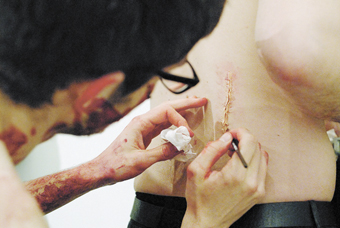Uninvited Guests: The art of wounding
Marie-Anne Mancio faces up to Univited Guests

Uninvited Guests, Aftermath
photo: Adam Faraday
Uninvited Guests, Aftermath
An archaic metal hospital bed, syringes, cotton buds, bottles of cleansing liquid and stage blood. Three performers (Neil Callaghan, Richard Dufty and Simone Kenyon) devise wounds for themselves and for one another whilst a fourth (Duncan Speakman) moves between them with a contact microphone (like a kind of stethoscope), sampling sounds from the performers’ bodies.
Instead of the typical doctor-patient ritual (patient points to where the pain is; doctor makes a stab at a diagnosis), one performer indicates where he would like his wound and another creates it. The marks are produced with skill. Flesh-coloured putty is rolled between the fingers, then painstakingly applied to the hand with a spatula; a needle draws a thin line in the raised skin before fake blood is added, often drop by drop with a pipette. The care and precision with which the performers slowly create these fake injuries is at odds with expectations that constellate around violence. I start to invent scenarios to explain the gashes: the woman tripped on a cracked paving stone; the man in the suit punched in a lunchtime brawl. The performers contemplate their own wounds with detachment; sometimes they smile at one another as though congratulating themselves.
There is something satisfying about this work appearing in a Live Art context. It references the kind of body art of pain made iconic by Gina Pane, Marina Abramovic, Orlan and others. These marks are not real. Yet despite being so close to the wounds, indeed despite seeing them being made, it’s hard not to be taken in. The room is hot. I start to feel squeamish. A hand is dangling in my face, dripping with fake blood. There are already bloodied footprints on the floor. As the work progresses, the narratives I am creating have to alter. The accidents must become more serious. Now we are in the world of car smashes, train collisions; passengers too damaged to recover. Cuts multiply like some contagious disease, a cruel science fiction scenario where wounds are growing on the walls. Hours later, the room looks like a murder scene; later still, something out of a horror movie. By the end, even the audience is feeling ‘wounded,’ our participation made explicit.
The effect of this disturbing and visceral experience is to confront us with our own vulnerability, our fears. The performance also plays on our reluctance to look and our inability to look away, something recognised in the documented accident photography of Enrique Metenides. We are caught in this dilemma but the durational nature of Aftermath allows us to leave and re-enter at will, coming back to gawp at the objects of our fascination until we can bear it no longer. And just as real patients might take home anything from their hospital wristband to their gallstones (bottled) as a testament to their survival, so Uninvited Guests provide us with an open sore of our own.
Bristol-based Uninvited Guests formed in 1998 and have toured widely with provocative performances that try to make sense of a media-saturated culture in which virtual interactions and memories of TV or movies are as much part of our experience as intimate dialogues with lovers. Uninvited Guests focus mainly on performance, but also work in installation and digital media. Uninvited Guests are Arnolfini Associate Artists.
Aftermath, Uninvited Guests with Duncan Speakman, Gallery 5, Arnolfini, Feb 3
RealTime issue #72 April-May 2006 pg.






